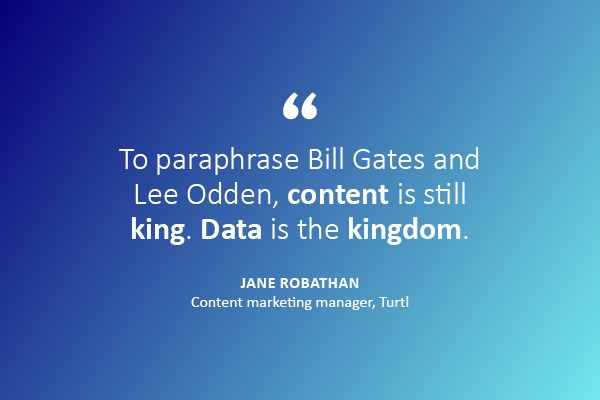The deeper value of digital content

- 15 March 2024
As brands move into a digital-first mindset, there are added benefits and rewards for both businesses and consumers. Jane Robathan, content marketing manager for digital platform, Turtl, explores the positive impact of turning to digital.
Unless you live under a stack of National Geographics, you’ll have some sense of the volume of digital content in the world. Just to put things into perspective, every day there are around:
- 7.5 million blogs published
- 3.5 billion searches on Google
- 34 million videos uploaded to TikTok
- Over 2 million LinkedIn posts created
- 95 million photos and videos are shared on Instagram
It’s a pretty huge industry. In 2022, global content marketing revenue was worth around $63 billion. It’s thought it will reach around $72 billion by the end of 2023 and grow to roughly $107 billion by 2026.
Figures swell further when we look at market size, which is predicted to grow to $584 billion by 2027 - driven largely by a growing number of social media users.
Content acquires customers, generates leads, and creates demand. Creators are up against challenges presented simply by the size of the machine.
To say it’s noisy out there is an understatement. Content marketers can no longer release well-written, keyword-optimized content and hope for traction. We’re not just vying for SERPs anymore. We’re working to get noticed, resonate, and synchronize effortlessly across multiple channels and up against eye-catching reels, hilarious GIFs, and every type of scroll-stopping new media.
Heads turn at things that move, things with sound, things that entertain. Our eyes rest for a split second before deciding whether to move on. And with so much choice, distraction is a nano-click away. Millennials and zoomers (Gen Z) are evolving dwindling attention spans at 12-8 seconds respectively. Of any generation to date, zoomers are reported to have the shortest attention for ads at around 1.3 seconds.
Combined, these digitally developed cohorts will account for 70% of the US workforce in two years. It’s not only this, but the expectations of an audience who have grown accustomed to enhanced, deeply personalised content experiences from their favourite entertainers and retailers. So, what’s a marketer to do?
We say lean in hard to digital. It’s the only content that gives us something remarkable about our audiences: Data.
A win-win data loop
If we use web data to track page traffic, blog popularity, and user behaviour, why aren’t we making sure our acquisition, demand generation, and retention assets are similarly analysed? To think that critical content is published with old media - incapable of providing data - is extraordinary.

Let’s look at thought leadership whitepapers. The average cost of producing a whitepaper in the US is between $4,500-7,000 with high-end costs touching $10,000. In the UK, average costs veer upwards of £3,000. Then you’ll be promoting your paper across paid media for lead gen. Whitepapers are usually published as PDFs with a maximum data offer of ‘number of downloads.’ Is this enough for prized content when we have the technology to see so much more?
Imagine knowing who has gone in for a second or third read, what exactly they spent time looking at, or if they shared the paper. Likewise, who bounced and wasn’t interested?
Now you’ve collected contact details from the people who downloaded your paper. But how do you manage a list of thousands of new contacts? How do you prioritise leads or see who is actively interested in what you’ve published?
Granular reader data gives us profound intent insights. What if you used content software that helped score leads and segment audiences? Content engagement data can be organised to show us all of these things.
You’d be able to identify readers by intent, clearly define their funnel stages, pass the warmest leads to sales, and identify exactly the right conversation openers.
“To paraphrase Bill Gates and Lee Odden, content is still king. Data is the kingdom.” Jane Robathan, content marketing manager at Turtl.
Back to basics
Old content formats can’t display the rich media our readers love to consume - you simply can’t embed video content into a PDF. Trailblazing platforms are capable of benchmarking content across an organisation or industry or scoring your content by using collected data, to help increase its performance. You can place triggers inside digital content like whitepapers, and use connected tech to kickstart relevant content workflows - directly from reader interactions.
When we consider market impact, once someone has read your whitepaper what did they think of your brand? Can they remember what they read? Will you and your carefully crafted paper become forgettable - lost among the next wave of more-clickable content?
Early interactions are an opportunity to deliver a brand experience where new relationships begin with sure-footed trust and credibility. Brand perception and message recall are improved with one of digital content’s most inclusive features: interactive content. And interactive content brings more data points ready to mine.
Lumen Research presented the same content from one brand as a PDF and a digital document. Five times more readers perceived the brand more positively simply because they consumed the content in a more engaging digital format. That’s not all, people also remember more about what they’ve consumed.
“Over three-quarters of marketers found that mixing interactive content with other marketing activities enhances message recall.” - Content Marketing Institute
Around 87% of marketers say that interactive content outperforms static content. People are drawn to content that includes them. What matters is you’re building a relationship with readers by inviting engagement, all while collecting more data about readers’ preferences.
“Interactive content, such as quizzes, polls, and interactive videos, will become more popular in 2024. Such content will engage and captivate the audience, and provide a more immersive and interactive experience. Interactive content has become a powerful tool for marketers to engage and connect with their audience.” - Martech Series
Think of teams surveying customers for product-led or customer-led growth, or gaining direct feedback from colleagues to improve company culture. Digital documents make effective training manuals when you use interactive summary questions between modules to solidify learning.
Insure your content by ensuring effective data capture
Knowing more about your audience means you serve better future content experiences. If you centralise engagement data with CRM data, you can do this very well indeed. Look at engagement data alongside customer lifetime value data to see who your best-fit customers are. What kind of content drove them into your pipeline and what pushed them through it?
Now imagine a digital document that adjusts language preferences for the team in Indonesia, or switches out video, text, and visuals for your German audience - even after publishing. Adapting content for audience segments is a personalisation tactic we’re used to seeing on web pages, but tech can now personalise your most expensive lead-gen assets - like whitepapers.
Personalised digital documents can be geo-driven, topic-driven, organisation-driven, and sent individually, or to thousands of accounts simultaneously. You can control exactly what you’d like to personalize - text, images, charts, 3D tours, polls, audio, or video - for any number of sends.
For true customer centricity, deep levels of personalisation can now be user-led. Digital documents can ask people what they’d like to read next so marketers can make it happen - or use custom workflows to automate the process.
“Most marketers (57%) cite creating the right content for their audience as a challenge. This is a change from many years when “creating enough content” was the most frequently cited challenge.” - Content Marketing Institute
Hyper-relevance has never been more important, and the drive for quality over quantity will be backed by Google’s upcoming search shake-up. Generative search will be personalised and conversational, feeding expectations for deeper content relevance beyond daily services like Netflix and Spotify. Content will need to be ultra-high quality always putting readers’ interests first. It’s impossible to serve content like this without the data offered by digital.
Want to develop a measurable and effective content marketing strategy that delivers value throughout the customer journey? CIM’s Content Strategy training course can help! Sign up today to learn more about strategy, best practice, segmentation and how to stay ahead of the competition.

Tags:
- 0 views

 FAQs
FAQs
 Log in
Log in
 MyCIM
MyCIM






